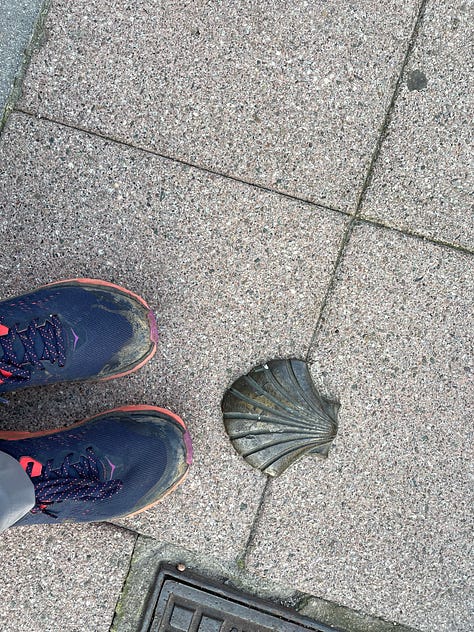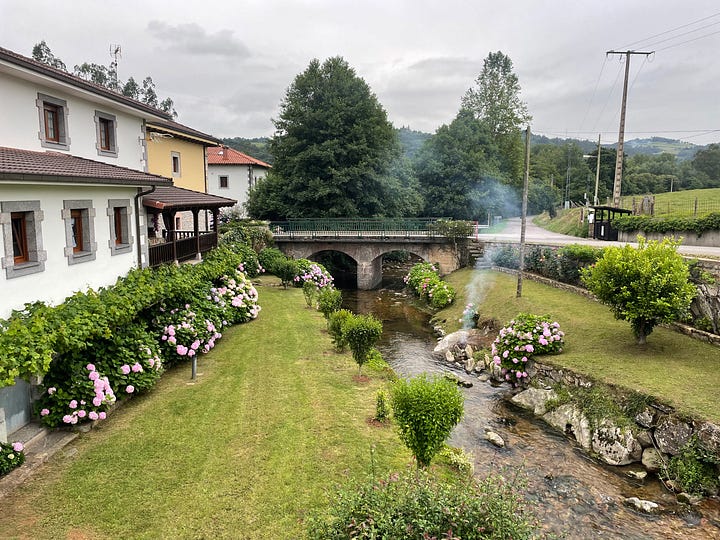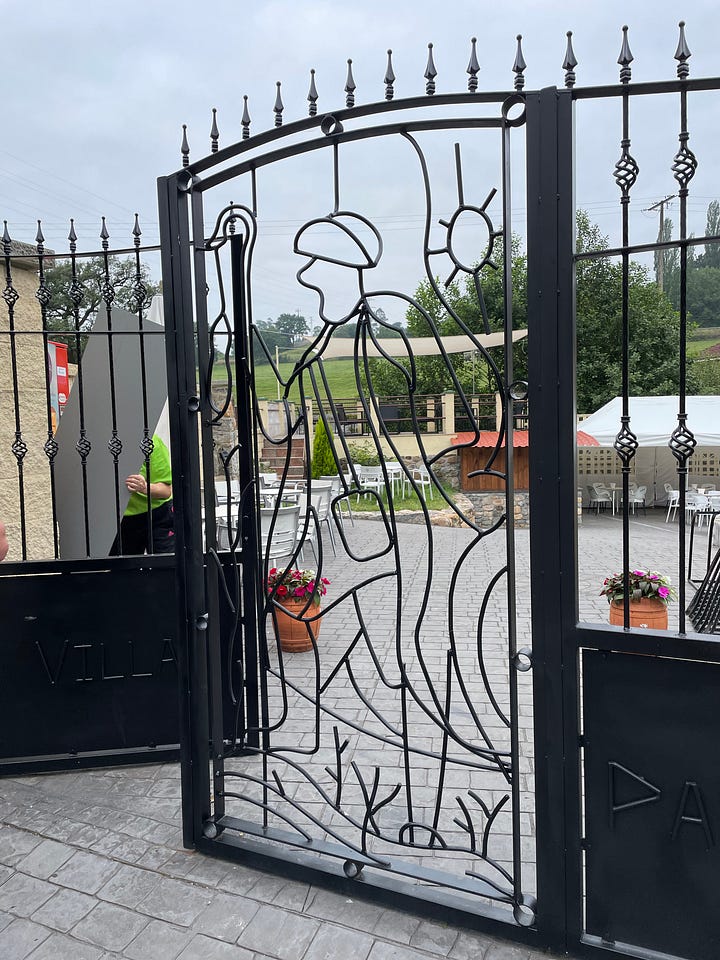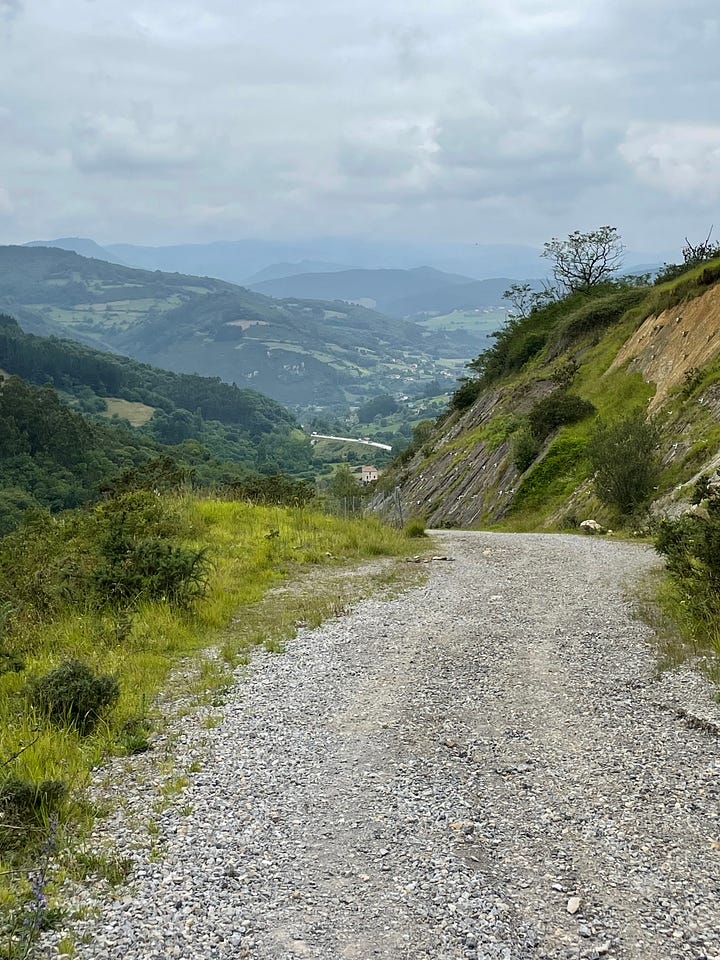014: There’s No Prize for Fastest Camino
Because pushing yourself too hard helps no one—and ruins the magic.
Hello Camino friends! Here’s what’s in this issue:
📆 “How Long Does The Camino Take?”
👟How to start your Camino training
📞Camino Connections Calls are open for May. Let’s chat!
📸Scenes from the Camino:
🥾How to get help planning your Camino.
Are you getting my posts directly to your email or Substack feed? If not, click here to join us.
Let’s get started!
📆How Long Does The Camino Take?
I was watching a video yesterday about a couple who walked the Camino Primitivo together (one of the hardest routes of the Camino de Santiago). The husband is the YouTuber—very excited, thrilled to be doing the Camino. The wife? It would be hard to find a woman more miserable.
Like many YouTubers, they were young (late 20s? maybe early 30s?) and were doing upwards of 30 km (18 miles!) in a day. I promise you: I’d be pretty miserable doing a Camino like that. I would refuse to appear on my husband’s YouTube video. And we would probably have broken up by the time it was over.
So . . . don’t do that.
The Camino is meant to be savored. The cliche is true: it’s about the journey, not the destination. So do what you can to enjoy the journey. I promise you: they’ll be plenty of hardships along The Way. No need to create them for yourself.
So how far should you walk in a day? To quote my friend Lynne, “Don’t should on yourself.”
That said, a comfortable daily walking distance is something you need to know in order to plan your trip.
—
“How many of you have done a long hike recently?” I asked a room of 45 Camino hopefuls. The majority held up their hands.
“And how many of you did another long hike the next day?”
Not a single hand went up.
“And the next day?”
My point was made.
—
When I talk to people who attended one of my Camino talks—whether they attended recently or years ago—the above exchange is the one they remember most.
I don’t do it to scare people. I do it to help people really internalize what the Camino is like physically: for most, it’s like nothing they’ve ever done before.
Some have considered how far they can walk in one day. But rare is the person who realizes the importance of daily walking in preparation for the Camino. And, ideally, a lot of it.
My audience is usually all over 50 and interested in walking a Camino. To bring their spirits back up, I then tell them the following:
“But here’s the good news. On the Camino, your only mission each day is to walk. So you don’t walk for 10 or 12 miles all in one shot. You have time to take breaks. Stop at a cafe. Have a coffee. Meet strangers who become friends for an hour, a day, or a lifetime. Walk a little more. Stop to catch your breath. Stop to take in a scene that takes your breath away. Stop to take pictures. I’ve even just stopped and plopped myself on the side of the trail just because I need a break.”
Somebody sticks their hand up. “So how long does it take you to walk 12 miles?”
“About six hours.”
The mathematicians in the group are taken aback. “That’s only two miles an hour. Normal walking pace is 3 miles an hour,” they say incredulously.
“What I’m saying is that from the moment I step foot on the trail until the moment I arrive at my destination—that’s six hours. In that time, I may stop for an hour and have a snack. It may take me twenty minutes to “walk” a few feet as I see a vista I want to capture perfectly. I slow down on the uphills. I stop for another break.”
Recently, I was talking to a client who just finished his Camino. “When you said that 2 miles per hour thing, I thought, ‘Speed it up, girl!’ But you were right.”
I know my audience. I’m not talking to the 23-year-olds with boundless energy. I’m talking to you (maybe-much-more-than-)over-45-year-olds. That’s who I am. That’s who I write all of this for. That’s who I help plan Caminos.
Over twenty-five years ago, a wise woman told me, “Be careful about taking advice from people who have never done it.” That advice has served me well—it helped me resign from jobs, travel on my own, and finally it helped me to just listen to the advice and very quickly assess whether the person was speaking from experience or just their own fears.
So for your Camino, not only do I recommend only taking advice from people who’ve done it. . . I also recommend listening to those who’ve done it in the way you plan to do it.
Sure, you can still watch that video that 20-something made about their Camino experience. But more valuable? Talk to those of us who are your age. Who’ve done multiple Caminos. In all sorts of seasons. In all kinds of weather. Those of us who’ve stayed in hotels, pensions, and paradors—with private bathrooms. And sheets. And towels.
But more important than any of that? Listen to YOU. Just pause. Close your eyes. Take a few deep breaths. Then ask your question. And listen for the answer.
With love,
Rebecca
Did someone forward this to you? Sign up to get Camino de Santiago advice, stories, and ideas every Sunday by clicking below.
👟How to Start Training for the Camino de Santiago
This isn’t a race. Nor a marathon. It’s a multi-day walk. So get out there every day — even if it’s just 15 minutes to start.
When training, I invite friends to walk with me. “Oh — I couldn’t keep up with you,” some say.
“I’m not going for speed. I just need to walk,” I’d respond.
Get out there and walk. Start with a few miles. Or less. Whatever you can do. Don’t aim for distance—aim for daily practice. Ideally with the socks and shoes you’ll use on your Camino, though don’t let that stop you from starting your training.
Walk the same distance the next day. And the next day. And the next day.
Write down your daily distance or steps. (All cell phones now track this—you may just not know where to find the info. Ask your nearest 25 year old.)
After a few days or even a week, increase your daily distance by another half-mile.
Repeat that for a week. Write your daily step count or distance each night.
Continue increasing your distance a week at a time. Take note of what hurts and figure out how to fix it.
Getting bored? Call a friend. Listen to music. Or a podcast. Just keep walking.
Some people get up to 8 miles or more per day before they leave. Some people don’t do any training at all. And everything in between.
Remember you can take breaks. There may not always be a bench or café. So you may have to sit on the side of trail—and hopefully you can get back up again😂. If not, another pilgrim will be along eventually to help you if you’re on the Camino. Though if you’re out in your local park, I can’t promise you that.
📞Camino Connections Calls
What are these calls? Every month, I open up 3 spots each for 20-minute conversations with members of this community. No agenda, no pitch—just a chance to connect person-to-person.
Why am I doing this? Because the thing I love most about the Camino is connecting with others. This is my way of saying thank you for being part of the Camino Calls community.
Who is this for? Anyone who wants to have a genuine human connection. You might want to ask Camino-related questions, questions about my life as an ex-pat in Spain, or maybe you just want to say hello. All are welcome!
How it works:
Show up on Zoom ready to connect
Enjoy the conversation.
It's first-come, first-served, and just one slot per person. If you've joined me for one of these calls in the past three months, I kindly ask that you allow new community members to grab these spots. I can’t wait to meet you!
📸Scenes from the Camino:
Camino Primitivo, Day 1
The Camino Primitivo is often called the most beautiful—and one of the most challenging—routes to Santiago. It starts in Oviedo and stretches 195 miles (313 km), typically taking 16 to 20 days to complete.







🥾Ready to start planning your Camino?
Rebecca Weston is an American who walked her first Camino in 2012.
She helps people 45 and over plan their own walks on the Camino de Santiago through her business The Camino Calls.
She and her husband live in Spain in a town of 6500 people on the Camino del Norte. She’s walked more than a dozen Caminos, spent many days volunteering along the trail, and if she’s not walking one now, she’s planning the next—and would love nothing more than to help you plan yours, too.



